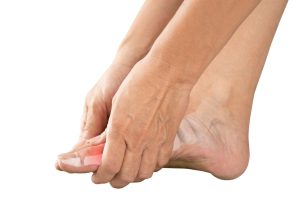Gout results from uric acid buildup in the body, leading to painful crystals forming in the joints. Uric acid develops when your body breaks down purines, a substance found in many foods and drinks like organ meats, anchovies, and beer. If too much uric acid accumulates, it will cause crystals to form in the tissues around a joint, causing inflammation and intense pain.
However, just because you have high uric acid levels in your blood doesn’t mean you’ll develop gout. Other risk factors can also contribute to the development of gout, such as high blood pressure, obesity, genetic factors, certain medications, and chronic kidney diseases.
Gout symptoms usually come on suddenly and can last for days or even weeks. Because they occur suddenly, they are often referred to as “flare-ups.” These flare-ups can be incredibly debilitating, leading to severe pain and limitation of movement.
Initially, the pain is typically felt in one joint (usually in the foot — often starting in the big toe), but it can spread to other joints over time (including in the hand and elbow). Other symptoms include redness, swelling, and tenderness around the affected area. Repeated gout attacks can cause damage to the joint over time, resulting in chronic pain.




















